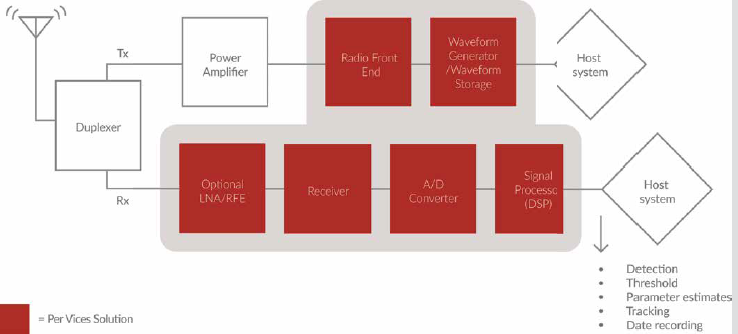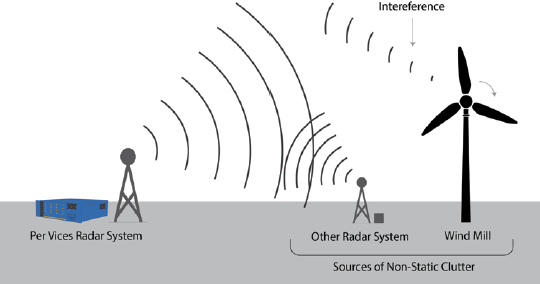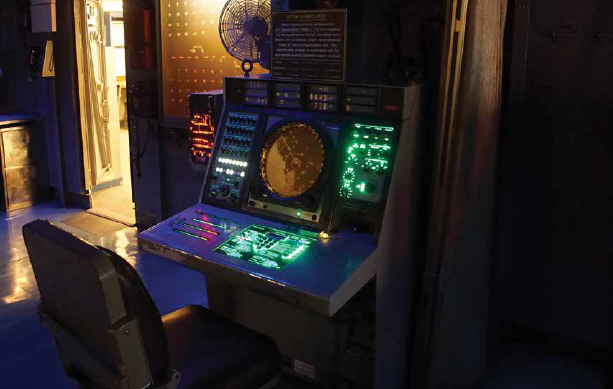Software Defined Radio for Radar Modernization & Service Life Extension Programs
The fundamentals of defense systems are changing. Technology shifts are happening at an unprecedented pace, putting us leaps and bounds ahead of where we have come from, and the electronics and components critical to modern warfare need to keep up with these advancements.

Radar systems, like many life and mission critical systems, are built and designed with the expectation that they will last for many years in service. Since this time line is quite long when compared to the lifespan associated with many electronic components, many of these radar systems require Service Life Extension Pro-grams (SLEP) at approximately the mid life of the radar system or must be replaced by a new modernized radar system. The SLEPs offer a path forward to replacing or upgrading a sub-set of the radar system in order to help address component obsolescence without the need for replacing the entire radar system, while radar modernization offers a path for replacing the entire legacy system with a new and modern system with new features, capabilities, performance enhancements, and maintainability.
In either option above, software defined radios (SDRs) offer the perfect solution. SDRs are radio systems that operate across a large part of the spectrum but have all the decoding and use completed in software as opposed to traditional systems where this is completed in hardware. This results in SDRs enabling the replacement of some hardware components with software. To explain the architecture of a typical SDR system, let’s analyze the data flow of a radar system. From Figure 1, we see there are two radio functionalities required; transmit and receive. On the transmit side, a digital waveform is generated, converted to an analog signal, and transmitted. On the receive side, the data returning to the radar system goes through a radio receive chain and is then converted to a digital signal and processed. In an SDR, both the transmit and receive functionalities can be achieved with plenty of flexibility and within the same unit while ensuring excellent phase coherency and isolation. This flexibility extends from the radio front end which allows operation across differ- ent RF bands including L-band, S-band, X-band, and Ku-band, along with high and adjustable radio bandwidths. These systems can also offer different combinations of independent radio re- ceive chains and radio transmit chains to best meet the system requirements. In addition, all of the radio chains are phase coherent and of- fer excellent stability. On the digital side of the SDR, the on board FPGA allows for waveform storage, waveform generating, and triggers to transmit the specified waveform at a specified waveform at a specified time – all desirable features for transmit functionality of a radar system. For the receive functionality, the FPGA also allows for additional DSP to be performed on the device, including filtering, digital up conversion and digital down conversion.
As previously mentioned, SLEP offer solutions to handle component obsolescence or performance issues that exist due to new mandates of the equipment. These obsolescence issues not only create availability problems but also impacts the overall maintenance, support costs, and time to repair in sourcing these obsolete components. In many cases, the best solution involves replacing only the components or parts of the system that are going obsolete, as opposed to replacing the entire system, as this approach helps to reduce costs, complexity, and a lengthy re-certification program. For these instances, software defined radios are a great solution as they offer a solution for many parts of the system including the radio receive chains, radio transmit chains, and DSP component. The result is the ability to replace, for example, an obsolete radar receiver or ra-dar transmitter with an SDR, without need-ing to change the existing duplexer, amplifier, processing unit, or control unit. By using the SDR in this capacity, system integrators and radar manufacturers can realize significant cost savings while also reducing supply chain complexity and overall system complexity. With the flexibility afforded by the technology, SDRs are able to be easily configured for integration into legacy systems while ensuring no other changes to data formats, interfaces, or other considerations are required. In turn, this newly integrated component, the SDR, is de-signed for longevity, ease of maintenance, and overall extends the life of the radar system as a whole. As an added benefit, the integration of the SDR into the system can result in improved performance and reliability through the use of state-of-the-art technologies, although these are also sometimes limited by other parts of the legacy system and may require a radar modernization.

This leads to the other option for managing near end of life radar equipment; replacing the entire system with a higher performance and modern solution. The decision to move forward with a full replacement may also occur for a variety of reasons including performance, cost to service, reliability, and anticipated maintenance of the aging radar system. With the advancements of other technologies and the changes in the environments in which radars are required to operate in, new and modern equipment may be required and the replacement option may be the best approach for the long term.
As new technologies have progressed, the requirements imposed on radar systems have progressed as well. It is now a very common need to have radar systems detect smaller tar-gets, such as drones and other UAVs, and these targets have become smaller as the technology powering these crafts has improved. Another trend in technological improvements impact-ing radar requirements falls under response times. Radars today are now expected to have a significantly faster response time when com-pared to the requirements of the past in order to keep up with evolving threats and transformations to targets of interest.
Similarly to the changing expectations due to new technologies, radars today must also adapt to changes in the environments in which they operate in. When compared to the past, radars today need to accommodate a greater presence of non-static clutter such as wind turbines, communication towers, in-creased air traffic, and other defense systems. Figure 2 (on previous page) illustrates some of these sources and the impact they have on radar systems today. The increase in types and numbers of these sources of clutter intro-duces new challenges ranging from RF interference, such as other radar systems, to physical interference, such as wind mills. These environmental changes has added additional requirements for radars today, which all lead to radar modernization programs.
Once again, SDRs are a great fit to address the evolving requirements associated with the radar modernization programs. Aside from the need for fewer pieces of equipment and components, and therefore a smaller footprint, SDRs offer superior flexibility and performance demanded by radar systems to-day. The transition from a traditional, analog intensive architecture to a new and modern digital architecture is one of the reasons why SDRs can offer this flexibility and performance increase. By having more of the system functions performed in a digital domain, the system becomes inherently more flexible for upgrades, new features, and increased performance at the same pace as advancements in digital technologies. In particular, SDRs are capable of performing advanced DSP algorithms, reducing the burden on other parts of the system and offering a more integrated solution. The SDR can also be used for waveform storage, triggering, digital filtering, digital up conversion and digital down conversion, enabling more done on a single unit. Moreover, due to the high stability and accu-racy of the time source within SDRs, these systems can be used to keep system time and provide a common clock to all parts of the system, helping ensure phase and stability requirements are met at a system level as op-posed to individual component levels.
Overall, SDRs are an ideal choice for both service life extension programs or new radar modernization programs. The integrated de-sign, small form factor, flexibility, and high performance of these SDRs is beneficial for both types of programs with a significant cost savings expected as SDRs are easily integrated and offer a less strenuous maintenance and support schedule. When selecting the best SDR for either of these programs, it is import-ant to consider the performance, including frequency of operation, number of channels, multiple input multiple output (MIMO) operation, bandwidth, latency, and FPGA capabilities. It is also important to consider vendors with experience in the radar market as this helps to reduce costs, complexities, and will result in an easier integration effort. Many SDRs are still offering lower performance solutions, however, there are some vendors who do offer mission critical SDRs that have been and can continue to be integrated into radar systems for both SLEPs and new modernization efforts.

